Quantum Hi-Tech Merchandising Private Limited, popularly known as QHMPL has been producing quality electronics since 1992. The company has recently launched a 10,000 mAh powerbank which is allegedly one of the slimmest powerbanks available in the Indian market now. I received it a few days back and followed the same testing which I used for Philips 13000 mAh Powerbank.
When we see both powerbanks side by side, the QHM 10KP 10000 mAh looks very slim and weighs less when compared to Philips 13000 mAh. It’s because the latter is a Li-Ion packed powerbank while the former is a Li-Po, and that’s why it’s very slim.
So, what exactly is the difference between Li-Ion and Li-Po batteries? Well, here you go –
Differences between Li-Ion and Li-Po batteries:
- Electrolyte: The main difference between Li-Ion and Li-Po batteries is the electrolyte. The Li-Ion batteries use liquid electrolytes whereas Li-Po batteries use solid polymer electrolyte [it can also be semi-solid/gel]
- Manufacturing Cost: Li-Ion batteries are usually high in energy density and cost less to manufacture while Li-Po cost 30-40% more, and have low energy density
- Shape: Li-Ion batteries are more rigid, and can only be designed in rectangular shape but on the contrary, Li-Po batteries are mouldable
- Discharge: Lithium-Ion batteries have more internal resistance and so the less discharge, while Lithium-Polymer batteries have less internal resistance, makes it discharge faster
- IC: Li-Ion batteries are quite explosive, and would require an Internal circuit for protection whereas Lithium-Polymer batteries are safe and they don’t require any IC
- Aging: When not in use, Li-Ion batteries ages quickly [even in 1 year of no usage] while the other doesn’t age much
- Usage: As Li-Po are lighter, slim and can be molded to any shape, they’re widely used in RC-cars and some mobile phones, while Li-Ion batteries are widely used in mobile phones including flagships as they’re cheaper to manufacture
- Priming: Both battery packages may not require priming, but in some cases, Li-Po do require an initial recharge for some ‘X’ hours [depends on manfacturer] before it can be used to charge some devices
Considering all these differences between Li-Ion and Li-Po batteries, each of them have their own pros and cons, but to make devices slimmer, OEMs should use Li-Polymer batteries and that’s what QHMPL did for QHM 10KP 10000 mAh powerbank. That’s why the powerbank looks slim and weighs less. But what about the performance? To know that, let’s dive into the review.
Quantum QHM 10KP 10000 mAh Powerbank Review:
Before we take a look at the power bank’s performance, let’s have a look at the key specifications and features.
QHM 10KP 10000 mAh Specifications:
- Powerbank Capacity: 10000 mAh
- Input Power: DC 5V/2A (MAX)
- Output Power: DC 5V/2A (MAX)
- Ports: 2 [+1]
- Life Cycle: > 500 times
- Battery Type: Polymer A Grade
Quite impressive specifications, isn’t it? Now let’s get started with the review –
Design:
 The design of Quantum QHM 10KP 10000 mAh is heavily inspired by Google’s Pixel 2 [white & black]. The only difference is the rear side of the phone’s design is the front-view of the powerbank. The curved black stripe at the top is actually an OLED screen which shows the battery percentage of the power bank.
The design of Quantum QHM 10KP 10000 mAh is heavily inspired by Google’s Pixel 2 [white & black]. The only difference is the rear side of the phone’s design is the front-view of the powerbank. The curved black stripe at the top is actually an OLED screen which shows the battery percentage of the power bank.
 Just to the right, you can find the power-ON/OFF button.
Just to the right, you can find the power-ON/OFF button.
 At the top, you can find 3 ports where the 2 are output ports each supporting 5V/2A whereas the other is the input port to fuel-up the powerbank.
At the top, you can find 3 ports where the 2 are output ports each supporting 5V/2A whereas the other is the input port to fuel-up the powerbank.
That’s exactly what you can find in the powerbank and nothing much. Now here comes the best part – performance.
Performance:
Just like the tests carried out to assess the Philips 13000 mAh powerbank, I followed the same for QHM 10KP 10000 mAh powerbank.
Prerequisites: Before I started the test, I charged the powerbank for straight 8 hours [as mentioned in the manual and on the website]. I used Zenfone 3 [3,000 mAh], Redmi 4A and Lenovo K3 Note for testing. Also, the powerbank was taking around 6-7 hours for a complete charge.
Iteration – 1:
How much time does it take to charge a 3000 mAh battery?
- Initial Spike: Like in Philips Powerbank, I’ve not seen any initial spike!
- Till 50%: It’s taking around 1.5 to 2 minutes for every 1% increase but when it started reaching 50% there’s a slight increase in time. Overall, the phone took an average of 95-100 minutes to reach 50%
- Beyond 50%: As said, it started taking more time for an increase in 1%. On an average, it took 2.5 – 3.5 minutes for every 1% increase.
After a couple of tests, I found that to charge a 3,000 mAh battery, the powerbank took 3 hours 30 minutes which is comparatively lower than a normal Li-Ion powerbank. Now here comes the big question, what’s the discharge rate of powerbank?
Iteration – 2:
How’s the powerbank discharge rate?
From the differences, it is evident that the discharge rate of Li-Po is relatively higher to that of Li-Ion batteries. Well, that’s actually true. I’ve charged a couple of devices and here are the discharge rate results –
- 100% – 75%: It took around 1 hour for the first drop.
- 75% – 50%: Again, the powerbank took 1 more hour for a 25% drop
- 50% – 25%: This time, the powerbank took more than 2 hours for a 25% drop
- 25% – 0%: It took more than 3 and half hours for a complete discharge
Overall, the powerbank lived for a total of 7 hours 50 minutes [average of 3 tests]. Well, the discharge rate would improve after a couple of charging cycles. Now, let me conclude it like this – For a price of Rs. 1,099 the Quantum QHM 10KP 10000 mAh, I’d say it’s a steal-deal. So, go ahead and purchase it right away.








